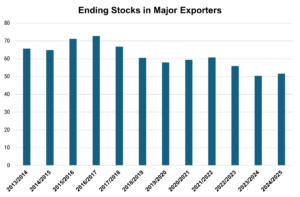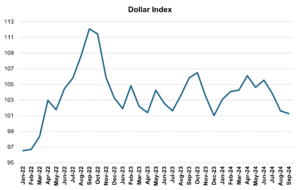On August 26, 2024, CBOT, KBOT, and MGEX wheat futures prices declined to four-year lows, pressured by the Northern Hemisphere harvest, adequate supplies in aggressive exporters, and generally low prices for feed grains and oilseeds.
Since then, futures prices sustained a multi-week rally, fueled by a weakening dollar, technical short covering from speculative funds, and a recent escalation in the Russia-Ukraine war. However, the question remains: has market sentiment shifted into a bullish market, or will the bearish trend hold? The following describes the current market factors and fundamentals influencing price trends.

Supply and Demand
Despite a cumulative 20.5 MMT drop in wheat production from the EU, Russia, and Ukraine, according to the September World Agricultural Supply and Demand Estimates (WASDE), the total output for major exporters was just 1% lower than last year and 1% below the five-year average. Moreover, total world wheat output sits at a record 796.8 MMT as increased production forecasts from the U.S., Australia, Canada, India, and China balanced the declines.
As the northern harvest wraps up and harvest related price pressure eases, markets will closely monitor the Southern Hemisphere, especially with another possible La Niña weather event. The September WASDE raised Australian production estimates by 2.0 MMT to 32.0 MMT on beneficial weather, while Argentinian estimates sit at 18.0 MMT, a 14% increase from last year.
Meanwhile, world wheat imports are down 12.0 MMT year over year as major importers buy less. Most notably, Turkish imports are down 2.4 MMT from last year, after Türkiye temporarily banned wheat imports to protect their domestic market.
Despite the overall lackluster import forecast, world wheat consumption continues to outpace production by 8.0 MMT. Likewise, ending stocks in major exporting countries sit at 51.6 MMT, 9% below the five-year average and 29% below the recent high in 2016/17.

Macro-Level Influences
In addition to basic supply and demand factors, broader influences on price such as interest rates, dollar strength, and risk premiums have bolstered wheat markets in recent weeks.
On September 18, the Federal Reserve cut its U.S. dollar interest rate by 50 basis points, the first cut in 4 years and the dollar has weakened in response to this change. While a weaker dollar has long-term benefits, such as making U.S. exports more competitive, it typically supports prices short-term as markets adjust. Lower interest rates also affect storage costs and calendar spreads for wheat futures moving forward.

Looking at risk premiums, renewed attention on the Russia-Ukraine war also helped support the recent rally. On September 12, Ukraine reported that a Russian missile struck a cargo ship transporting wheat to Egypt. If verified, this strike would mark the first attack on a grain vessel in open water and escalate tensions in the Black Sea. In response to the attack allegations, CBOT, KBOT, and MGEX wheat futures jumped an average of 14 cents. Speculative funds engaging in short covering have also intensified the upward pressure on markets, as investors look to benefit from the current rally.
What’s Next
With the market breaking from the downward trend, supply and demand fundamentals will establish long-term direction. Overall, despite the underlying low stocks in the global balance sheet, adequate wheat supplies and sluggish demand weigh on prices, seeming to reinforce bearish market sentiment.
However, in the short term, Federal Reserve policy decisions will affect interest rates and competitiveness, while the easing of harvest related price pressure and a renewed war risk premium suggest a potential for further gains.
By Tyllor Ledford, USW Market Analyst


